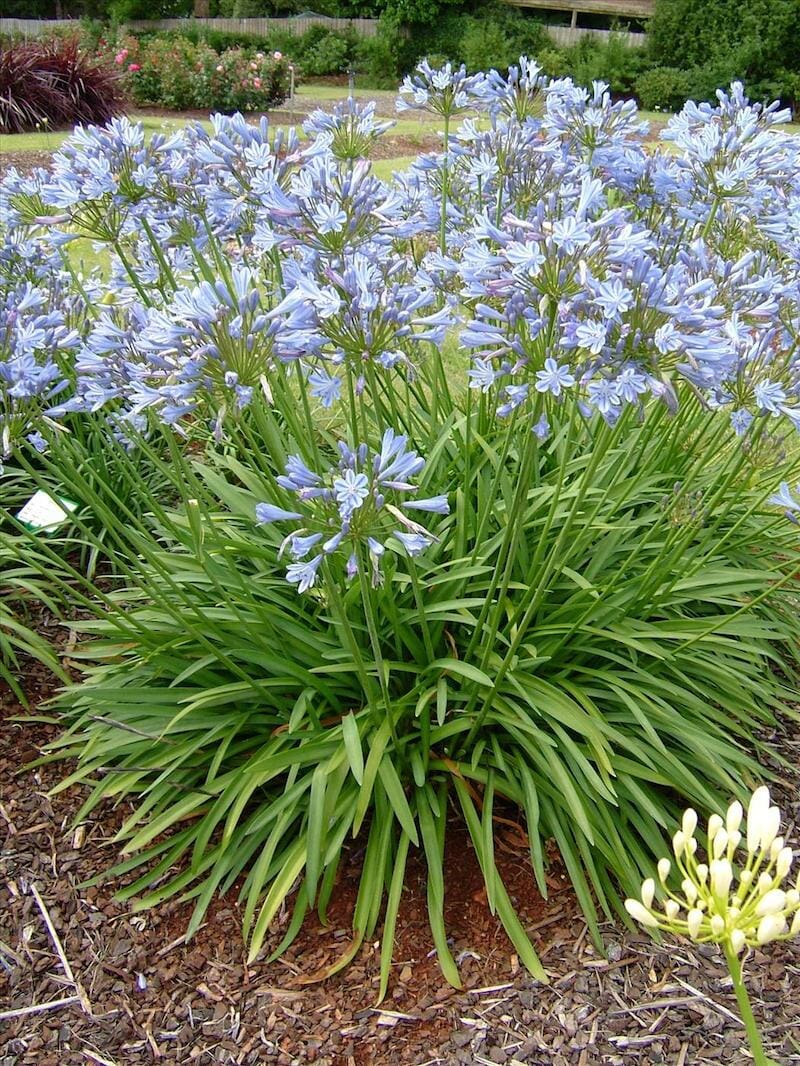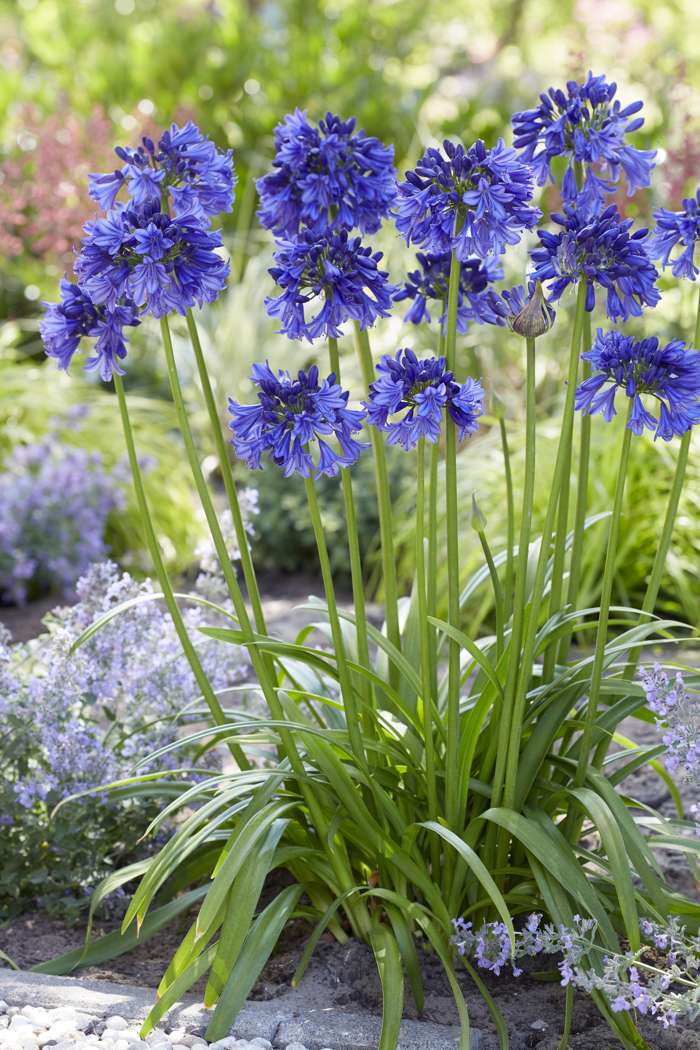Agapanthus Buddy Plants: Perfect Pairings for Your Garden
Agapanthus Buddy Plants: Perfect Pairings for Your Garden
Blog Article
Releasing the Secret to Effective Agapanthus Farming: Tips and Techniques for a Flourishing Yard
In the world of gardening, cultivating agapanthus efficiently calls for a calculated strategy that incorporates numerous elements of plant care. By recognizing the nuances of agapanthus cultivation, one can produce an atmosphere where these plants flourish and bloom abundantly.
Growing Agapanthus: Ideal Practices
When growing Agapanthus, proper soil prep work is crucial for guaranteeing effective development and development of these gorgeous flowers. Agapanthus, commonly called Lily of the Nile or African lily, thrives in well-draining dirt with a somewhat acidic to neutral pH level - Agapanthus. Before planting, it is important to modify hefty clay soils with raw material such as garden compost or peat moss to enhance drain and supply crucial nutrients for the plants
To grow Agapanthus, pick an area that obtains full sunlight to partial shade, as this will advertise healthy and balanced growth and abundant blooming. Dig an opening two times the size of the plant's origin sphere and position the Agapanthus at the same depth it was previously expanding. Gently backfill the opening with soil, weighing down strongly to get rid of any kind of air pockets around the roots.
Water the recently planted Agapanthus completely and proceed to keep the dirt uniformly moist, particularly during the plant's energetic expanding period. Agapanthus. Applying a balanced plant food once a month can even more support the plant's development and blooming. By adhering to these finest methods for growing Agapanthus, you can develop a sensational display screen of these captivating blossoms in your yard
Ideal Soil Conditions for Agapanthus
For optimal development and growing success of Agapanthus plants, making certain the soil conditions are excellent is crucial. Agapanthus prospers in well-draining soil with a slightly acidic to neutral pH level ranging from 6.0 to 7.0. This kind of soil permits for appropriate water drainage, protecting against waterlogging which can lead to root rot. To improve dirt water drainage, consider adding raw material such as garden compost or peat moss when preparing the growing website. Furthermore, Agapanthus chooses dirt that is abundant in nutrients, so incorporating a balanced plant food throughout the growing season can advertise healthy and balanced development and lively flowers.
:max_bytes(150000):strip_icc()/agapanthus-growing-guide-7368912_hero-a3585e4f9ffe4b99a73c7ad8eb4ebe48.jpg)
Watering and Feeding Tips
To make sure healthy and balanced development and vibrant blossoms, appropriate watering and feeding methods are crucial for effective Agapanthus farming. Agapanthus plants profit from regular watering, particularly throughout the expanding season.
When it pertains to fertilizing Agapanthus, a balanced fertilizer with equivalent components nitrogen, phosphorus, and potassium can be used in the spring to promote healthy and balanced development and blooming. Slow-release plant foods are excellent for giving nutrients progressively over a prolonged period. Prevent over-fertilizing, as this can lead to too much foliage growth at the cost of blooms.
Additionally, incorporating raw material like garden compost right into the soil can boost nutrient degrees and improve dirt framework, assisting in the total health and wellness of the Agapanthus plants. By adhering to these Bonuses watering and fertilizing pointers, garden enthusiasts can ensure their Agapanthus plants thrive and create sensational display screens of flowers.
Trimming and Deadheading Techniques
Appropriate trimming and deadheading techniques play an important duty in maintaining the health and aesthetic appeals of Agapanthus plants, matching the essential techniques of watering and feeding for effective cultivation. Pruning Agapanthus includes getting rid of spent blossom heads, dead or yellowing fallen leaves, and general shaping of the plant to advertise far better growth. Deadheading, the procedure of removing faded blossoms, not just enhances the plant's look but likewise urges additional growing.
When deadheading Agapanthus, it is recommended to trim off the blossom stem at the base using sharp, tidy shears. This procedure redirects the plant's energy from seed manufacturing back right into root and foliage development, advertising a healthier and much more durable plant. Normal deadheading can extend the flowering duration of Agapanthus and protect against self-seeding, which can lead to congestion.
In terms of pruning, Agapanthus read more usually take advantage look at here of a light trim after blossoming to clean the plant and urge fresh development. Reducing back the invested blossom stems and getting rid of any broken or dead vegetation aids maintain the plant's vitality and total look. Nonetheless, it is important to prevent cutting into the crown of the plant, as this can compromise its health.

Protecting Agapanthus From Vermins and Diseases
Applying efficient insect and disease management approaches is critical to securing the health and vigor of Agapanthus plants in farming. Agapanthus are normally sturdy plants, however they can still come down with numerous bugs and illness otherwise correctly cared for. One usual bug that affects Agapanthus is the Agapanthus borer, a caterpillar that passages into the plant, causing damages to the flowers and fallen leaves. To avoid infestations, routine examination of the plants is crucial. If borers are detected, they can be manually gotten rid of, or insecticidal soap can be utilized as a control step.
In enhancement to parasites, Agapanthus are at risk to conditions such as origin rot and fungal fallen leave spots. By staying alert and dealing with insect and illness problems immediately, garden enthusiasts can assist their Agapanthus grow and thrive.

Final Thought
Finally, effective growing of agapanthus calls for correct planting strategies, excellent soil problems, adequate watering and fertilizing, normal trimming and deadheading, and protection from diseases and parasites. By following these tips and methods, garden enthusiasts can guarantee a prospering garden filled up with attractive agapanthus blossoms. Agapanthus. Bear in mind to keep constant treatment and focus to detail to advertise the health and longevity of these sensational plants
When growing Agapanthus, correct soil preparation is important for making sure successful growth and development of these stunning flowers.Water the recently grown Agapanthus completely and proceed to keep the soil evenly damp, especially during the plant's energetic expanding period.For optimum development and flowering success of Agapanthus plants, making sure the soil conditions are perfect is critical. When growing or transplanting Agapanthus, guarantee the soil is well-prepared to provide the needed structure for the plants to establish themselves efficiently. One common insect that impacts Agapanthus is the Agapanthus borer, a caterpillar that tunnels right into the plant, triggering damages to the flowers and leaves.
Report this page